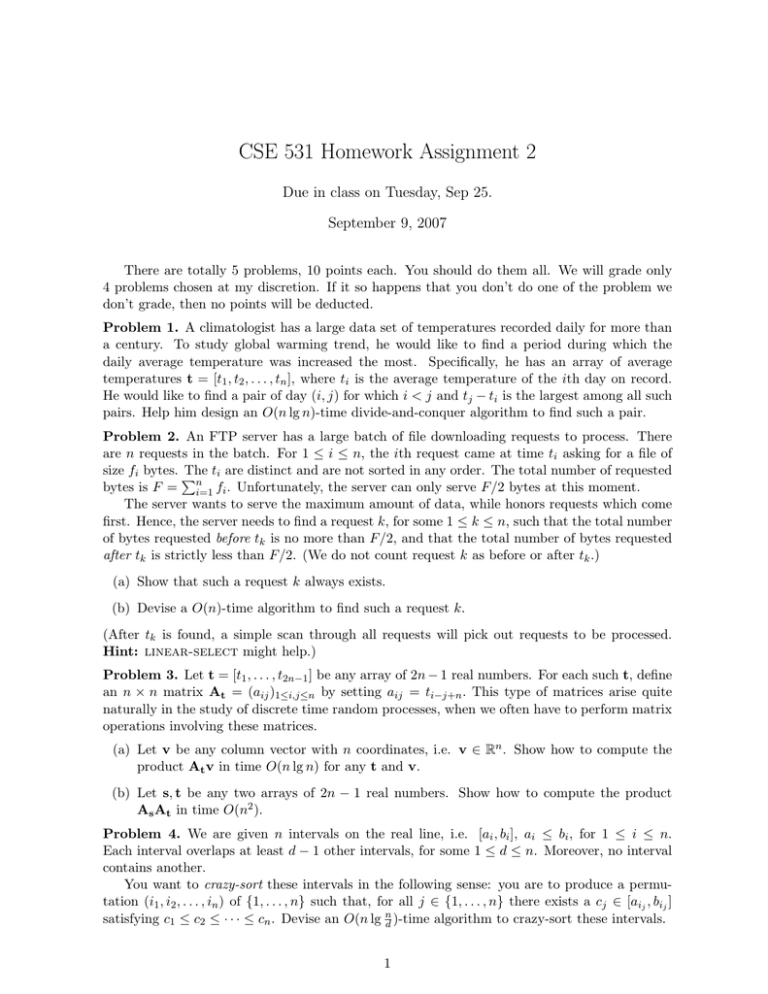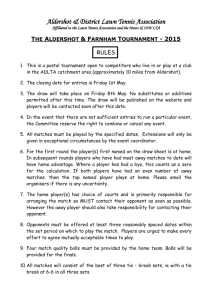CSE 531 Homework Assignment 2 September 9, 2007
advertisement

CSE 531 Homework Assignment 2
Due in class on Tuesday, Sep 25.
September 9, 2007
There are totally 5 problems, 10 points each. You should do them all. We will grade only
4 problems chosen at my discretion. If it so happens that you don’t do one of the problem we
don’t grade, then no points will be deducted.
Problem 1. A climatologist has a large data set of temperatures recorded daily for more than
a century. To study global warming trend, he would like to find a period during which the
daily average temperature was increased the most. Specifically, he has an array of average
temperatures t = [t1 , t2 , . . . , tn ], where ti is the average temperature of the ith day on record.
He would like to find a pair of day (i, j) for which i < j and tj − ti is the largest among all such
pairs. Help him design an O(n lg n)-time divide-and-conquer algorithm to find such a pair.
Problem 2. An FTP server has a large batch of file downloading requests to process. There
are n requests in the batch. For 1 ≤ i ≤ n, the ith request came at time ti asking for a file of
size fi bytes. P
The ti are distinct and are not sorted in any order. The total number of requested
bytes is F = ni=1 fi . Unfortunately, the server can only serve F/2 bytes at this moment.
The server wants to serve the maximum amount of data, while honors requests which come
first. Hence, the server needs to find a request k, for some 1 ≤ k ≤ n, such that the total number
of bytes requested before tk is no more than F/2, and that the total number of bytes requested
after tk is strictly less than F/2. (We do not count request k as before or after tk .)
(a) Show that such a request k always exists.
(b) Devise a O(n)-time algorithm to find such a request k.
(After tk is found, a simple scan through all requests will pick out requests to be processed.
Hint: linear-select might help.)
Problem 3. Let t = [t1 , . . . , t2n−1 ] be any array of 2n − 1 real numbers. For each such t, define
an n × n matrix At = (aij )1≤i,j≤n by setting aij = ti−j+n . This type of matrices arise quite
naturally in the study of discrete time random processes, when we often have to perform matrix
operations involving these matrices.
(a) Let v be any column vector with n coordinates, i.e. v ∈ Rn . Show how to compute the
product At v in time O(n lg n) for any t and v.
(b) Let s, t be any two arrays of 2n − 1 real numbers. Show how to compute the product
As At in time O(n2 ).
Problem 4. We are given n intervals on the real line, i.e. [ai , bi ], ai ≤ bi , for 1 ≤ i ≤ n.
Each interval overlaps at least d − 1 other intervals, for some 1 ≤ d ≤ n. Moreover, no interval
contains another.
You want to crazy-sort these intervals in the following sense: you are to produce a permutation (i1 , i2 , . . . , in ) of {1, . . . , n} such that, for all j ∈ {1, . . . , n} there exists a cj ∈ [aij , bij ]
satisfying c1 ≤ c2 ≤ · · · ≤ cn . Devise an O(n lg nd )-time algorithm to crazy-sort these intervals.
1
Problem 5. The Buffalo Tennis Association is about to establish a new Tennis tournament
called the Bufopen. The organizers do not agree with the current “binary tree” format of the
Grand Slams. They think it is unfair to the second best player as he/she could have been beaten
in rounds before the final match by the champion, and thus does not have a chance to be the
runner-up. (Pretty much everyone belonging to Federer’s branch is out of luck. Think Rodick!)
Here we assume the players’ strengths are totally ordered, namely if player A beats player
B, and B beats C, then we can safely conclude that A is stronger than C without playing C.
Consequently, the organizers of the Bufopen ask the students of CSE 531 to design a
tournament which can decide the best and the second best players in as few matches as possible.
1. Design such a tournament which uses only n + dlg ne − 2 matches, where n ≥ 2 is the total
number of players.
2. If we also want to determine the third best player, in addition to the first and the second
best, how many matches do you need in total?
3. Suppose there is a tournament format which determines the mth best player X, where
1 < m ≤ n. Show that after the tournament, one can identify the set of m − 1 players who
are stronger than X without any additional matches.
(Hint: Let S be the set of players who have beaten X directly or indirectly, then all
players in S are stronger than X. Prove that if |S| < m − 1, then there is some other
ordering of players’ strengths for which X is no longer the mth strongest, but the matches’
results are exactly the same as before.)
2






